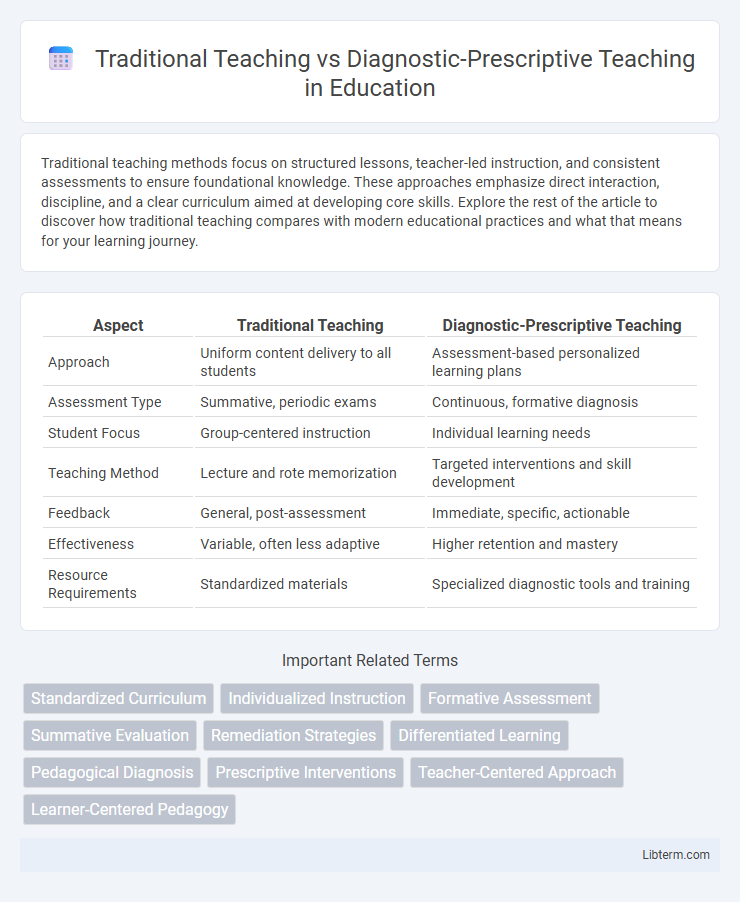Traditional teaching methods focus on structured lessons, teacher-led instruction, and consistent assessments to ensure foundational knowledge. These approaches emphasize direct interaction, discipline, and a clear curriculum aimed at developing core skills. Explore the rest of the article to discover how traditional teaching compares with modern educational practices and what that means for your learning journey.
Table of Comparison
| Aspect | Traditional Teaching | Diagnostic-Prescriptive Teaching |
|---|---|---|
| Approach | Uniform content delivery to all students | Assessment-based personalized learning plans |
| Assessment Type | Summative, periodic exams | Continuous, formative diagnosis |
| Student Focus | Group-centered instruction | Individual learning needs |
| Teaching Method | Lecture and rote memorization | Targeted interventions and skill development |
| Feedback | General, post-assessment | Immediate, specific, actionable |
| Effectiveness | Variable, often less adaptive | Higher retention and mastery |
| Resource Requirements | Standardized materials | Specialized diagnostic tools and training |
Introduction to Traditional and Diagnostic-Prescriptive Teaching
Traditional teaching centers on a standardized curriculum where instruction follows a fixed sequence, emphasizing memorization and uniform assessment. Diagnostic-prescriptive teaching involves assessing individual student needs to identify learning gaps and tailor instruction specifically to address those deficiencies. This approach promotes personalized learning paths, enhancing student engagement and mastery by focusing on targeted interventions.
Core Principles of Traditional Teaching
Traditional teaching emphasizes a teacher-centered approach where instruction follows a fixed curriculum and standardized methods aimed at uniform knowledge acquisition. It relies on repetition, memorization, and direct instruction to ensure mastery of content across all students. Assessment primarily measures retention and comprehension rather than individualized learning needs or diagnostic feedback.
Key Features of Diagnostic-Prescriptive Teaching
Diagnostic-prescriptive teaching centers on assessing individual learners' strengths and weaknesses through continuous evaluation to tailor instruction that addresses specific needs. This approach emphasizes personalized learning plans, targeted interventions, and flexibility in teaching strategies to enhance student comprehension and skill development. It contrasts with traditional methods by prioritizing diagnostic assessment as a fundamental tool for instructional decision-making and learner progress monitoring.
Historical Evolution of Teaching Methods
Traditional teaching methods, rooted in rote memorization and standardized instruction, dominated centuries of education by emphasizing uniform curriculum delivery and teacher-centered approaches. Diagnostic-prescriptive teaching emerged in the early 20th century, influenced by educational psychology and progressive education, focusing on assessing individual learners' strengths and weaknesses to tailor instruction accordingly. This evolution reflects a shift from one-size-fits-all pedagogy toward personalized learning strategies aimed at improving student outcomes through targeted interventions.
Curriculum Structure: Fixed vs. Flexible Approaches
Traditional teaching employs a fixed curriculum structure, emphasizing a standardized sequence of topics and uniform pacing for all students. Diagnostic-prescriptive teaching utilizes a flexible curriculum framework, adapting content and progression based on individual learners' diagnostic assessments and specific educational needs. This personalized approach enables targeted interventions, fostering improved student engagement and mastery of concepts.
Role of Assessment in Both Methods
Traditional teaching relies on summative assessments primarily to evaluate student learning at the end of instructional units, focusing on grading and ranking. Diagnostic-prescriptive teaching employs formative assessments continuously to identify learning gaps and tailor instruction to individual student needs, enhancing targeted skill development. The role of assessment in diagnostic-prescriptive methods is integral, guiding personalized interventions and enabling adaptive teaching strategies.
Teacher’s Role: Instructor vs. Facilitator
Traditional teaching positions the teacher as an instructor who delivers content and controls classroom activities, emphasizing direct instruction and authoritative knowledge transfer. Diagnostic-prescriptive teaching shifts the teacher's role to a facilitator, who assesses individual learner needs and designs tailored interventions to promote deeper understanding and skill mastery. This approach prioritizes personalized feedback, learner engagement, and adaptive support over standardized lesson delivery.
Student Engagement and Learning Outcomes
Traditional teaching often relies on uniform instruction and passive student participation, which can limit engagement and hinder personalized learning outcomes. Diagnostic-prescriptive teaching uses assessments to identify individual student needs, enabling tailored interventions that boost active engagement and optimize knowledge retention. Research shows diagnostic-prescriptive methods significantly improve academic achievement by addressing learning gaps and fostering student motivation.
Advantages and Limitations of Each Method
Traditional teaching emphasizes uniform instruction, enabling efficient content delivery to large groups but often neglects individual learning differences, limiting student engagement and mastery. Diagnostic-prescriptive teaching offers tailored interventions based on learner assessments, enhancing personalized support and addressing specific skill gaps; however, it requires more time, resources, and specialized teacher training. Balancing the scalability of traditional methods with the customization of diagnostic-prescriptive approaches can optimize educational outcomes and cater to diverse learner needs.
Choosing the Right Approach for Diverse Learners
Traditional teaching relies on uniform instruction where all students follow the same pace and content, which may not address individual learner differences effectively. Diagnostic-prescriptive teaching uses ongoing assessments to identify each student's strengths and weaknesses, tailoring instruction to meet diverse learning needs and improve outcomes. Selecting the right approach depends on classroom diversity, with diagnostic-prescriptive methods offering personalized support for varied abilities and traditional methods providing structured content delivery.
Traditional Teaching Infographic

 libterm.com
libterm.com